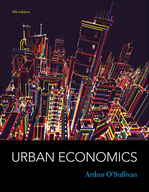Solution Found!
Heli-Segways for Workers Consider a region with 6 million workers and two cities (A and B), each with an initial workforce of 3 million (the utility-maximizing workforce). Suppose the heli-segway (a fl ying personal transporter) replaces the automobile, cutting commuting cost and increasing the utility-maximizing urban workforce per city to 5 million. The positively sloped part of the new utility curve is steeper than the negatively sloped part. a. Show the effect of the heli-segway on the urban utility curve in the typical city. b. A workforce of 3 million [is, isn’t] a stable equilibrium because. . . . c. Using the new utility curves, show the changes in the workforces of two cities, one that grows and one that shrinks. Label the initial point i and indicate the directions of the changes with arrows. d. The new equilibrium number of cities is _____ and each city has a population of _____ .
Chapter 4, Problem 2(choose chapter or problem)
Heli-Segways for Workers
Consider a region with 6 million workers and two cities (A and B), each with an initial workforce of 3 million (the utility-maximizing workforce). Suppose the heli-segway (a flying personal transporter) replaces the automobile, cutting commuting cost and increasing the utility-maximizing urban workforce per city to 5 million. The positively sloped part of the new utility curve is steeper than the negatively sloped part.
a. Show the effect of the heli-segway on the urban utility curve in the typical city.
b. A workforce of 3 million [is, isn’t] a stable equilibrium because. . . .
c. Using the new utility curves, show the changes in the workforces of two cities, one that grows and one that shrinks. Label the initial point i and indicate the directions of the changes with arrows.
d. The new equilibrium number of cities is _____ and each city has a population of _____ .
Questions & Answers
QUESTION:
Heli-Segways for Workers
Consider a region with 6 million workers and two cities (A and B), each with an initial workforce of 3 million (the utility-maximizing workforce). Suppose the heli-segway (a flying personal transporter) replaces the automobile, cutting commuting cost and increasing the utility-maximizing urban workforce per city to 5 million. The positively sloped part of the new utility curve is steeper than the negatively sloped part.
a. Show the effect of the heli-segway on the urban utility curve in the typical city.
b. A workforce of 3 million [is, isn’t] a stable equilibrium because. . . .
c. Using the new utility curves, show the changes in the workforces of two cities, one that grows and one that shrinks. Label the initial point i and indicate the directions of the changes with arrows.
d. The new equilibrium number of cities is _____ and each city has a population of _____ .
ANSWER:Step 1 of 5
Given data:
Heli-Segways for Workers Consider a region with 6 million workers and two cities (A and B), each with an initial workforce of 3 million (the utility-maximizing workforce). Suppose the heli-segway (a flying personal transporter) replaces the automobile, cutting commuting costs and increasing the utility-maximizing urban workforce per city to 5 million. The positively sloped part of the new utility curve is steeper than the negatively sloped part.
